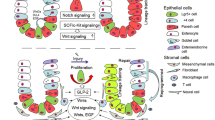Abstract.
Paneth cells (PCs) were described over a century ago as granulated cells located at the base of small intestinal crypts, the 'crypts of Lieberkühn.' Various histochemical staining procedures were developed that identified PCs based on their distinctive granule staining pattern. Early on, PCs were proposed to perform a specialized function other than absorption of digested nutrients, the predominant task of the small intestinal epithelium. Since then, many constituents of the PC granules have been biochemically characterized. The presence of various granule-associated antimicrobial substances and their release upon microbial challenge suggest that PCs function as specialized defense cells in the small intestine. Altered resistance to microbial infection in animal models with disrupted or augmented PC function provides further support for the host defense role of PCs. Other PC components suggest that PCs may also participate in the regulation of lumenal ionic composition, crypt development, digestion, and intestinal inflammation.
Similar content being viewed by others
Author information
Authors and Affiliations
Additional information
Received 6 June 2001; received after revision 26 July 2001; accepted 27 July 2001
Rights and permissions
About this article
Cite this article
Porter, E., Bevins, C., Ghosh, D. et al. The multifaceted Paneth cell. CMLS, Cell. Mol. Life Sci. 59, 156–170 (2002). https://doi.org/10.1007/s00018-002-8412-z
Issue Date:
DOI: https://doi.org/10.1007/s00018-002-8412-z




